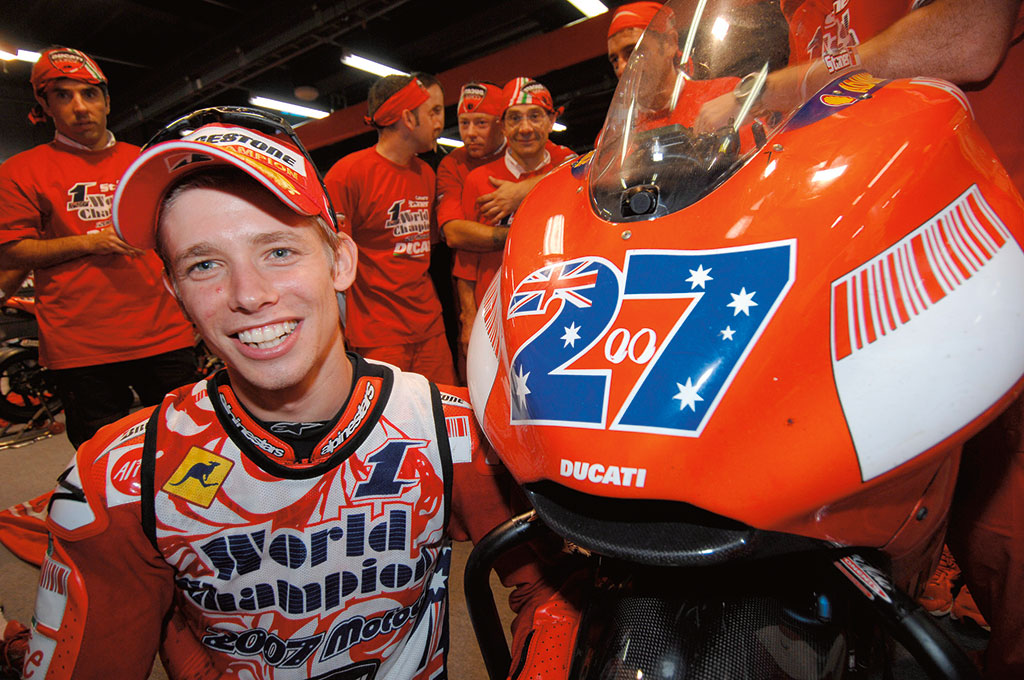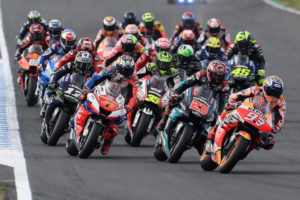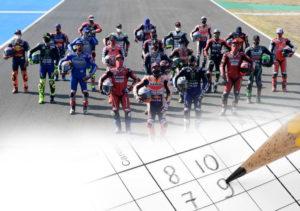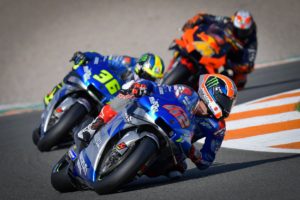The birth of MotoGP
MotoGP, the new queen class of the grand prix to replace the historic 500 class, was established in 2002; two of the most significant changes, which we could call epochal: end of the epic of 2 times with admission exclusively of the 4-time cycle and displacement increased from 500 to 990 cc.; in 2007 the displacement was reduced to 800cc and then increased to 1000cc, currently in force, starting in 2012.
In the first year of the establishment of MotoGP, considered as a transitional period, the 500 were also admitted to the championship.
Four manufacturers were ready for the start of the season with different engine solutions: Aprilia with a futuristic 3-cylinder in-line, Honda with a sophisticated 5-cylinder V, Suzuki with a four-cylinder V and finally Yamaha with a 4-cylinder in line vaguely related to that of the standard R1 powered by carburetors and 890 cc displacement , strangely lower than the maximum allowed.
The riders entrusted with the new prototypes were: Honda with Rossi and Ukawa at Honda, Yamaha with Biaggi and Checa, Kenny Roberts jr and Gibernau at Suzuki and finally Laconi in Aprilia.
All but two races won by Biaggi with Yamaha were won by Honda riders; Rossi won 11 while Barros and Ukawa won two and one respectively.
By virtue of these results Rossi, with the fabulous RC211V, won the first title in the history of MotoGP, his second personal title of the queen class.
MotoGP will prove to be a land of conquest for The Japanese Honda with 10 titles and Yamaha with 7, with the only exceptions of Ducati with Stoner in 2007 and Suzuki with Mir in 2020.
Ducati and Kawasaki also took the field in 2003.
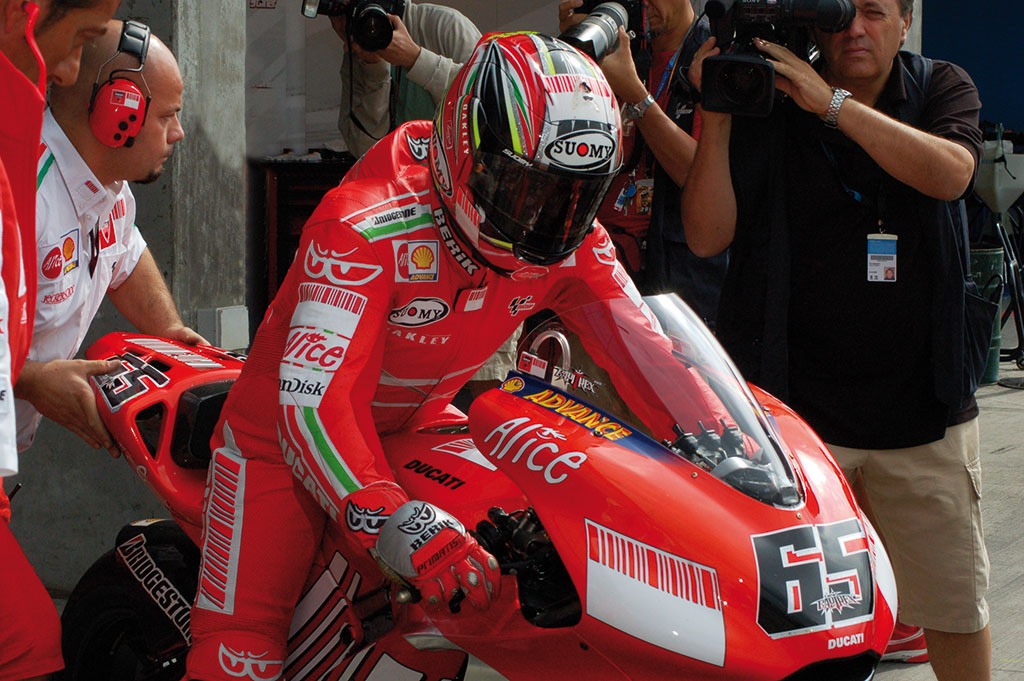
Ducati, for many years absent from the World Championship, in those years dominated the SBK and therefore saw in the new regulation for prototypes an opportunity to put to good use its extensive experience gained in the field of 4 times of great displacement.
The fundamental stages of Ducati’s history in MotoGP
- The Borgo Panigale house debuted in 2003 with the Desmosedici GP3 entrusted to the guidance
of Loris Capirossi
and Troy Bayliss and
it was a more than promising start. In the debut race in Suzuka, Japan Capirossi finished the race in third place; at Mugello Capirossi he took second place and scored the absolute maximum speed record with 332.409 km/h; by now the time was ripe for the first victory that came on time on June 15 at the Catalonia Grand Prix. Capirossi and Bayliss that year will collect another 8 podes. There has been no victory for an Italian on an Italian motorcycle since 1976, 27 years old, since Giacomo Agostini won the German Grand Prix riding the MV Agusta 500. - Since then Ducati has almost always won at least one Grand Prix per year; However, there have been dark, winless years, such as 2004 and the period between 2011 and 2015.
- On June 18, 2006, in Catalonia Capirossi and Ducati, due to an accident triggered by Gibernau, bid farewell to their likely first iridescent title in the Regina class.
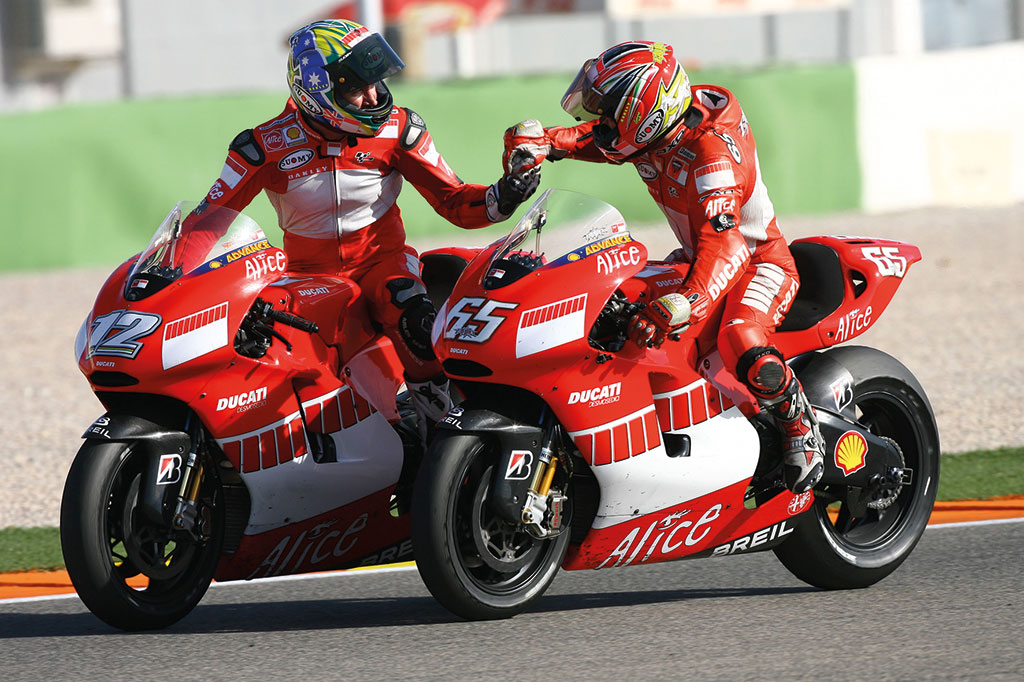
- The year ducati achieved the most MotoGP victories, eleven, was 2007, when Stoner, with 10 successes, graduated world champion and Capirossi won the Japanese GP.
- On July 17, 2016, with the placing in third place in the 2016 German Grand Prix Dovizioso took the Ducati GP16 to the 99th world podium in MotoGP but, considering also the third place won by Spaggiari on May 21, 1972 at the Grand Prix of Nations with the 500 twin-cylinder, the German podium is to be counted as the 100th of ducati in top class.
- After stoner’s last success at Phillip Island in 2010, Ducati went into crisis and to return to victory it will be necessary to wait until 2016 when Andrea Iannone in Austria and Andrea Dovizioso in Malaysia will take Ducati back to the top step of the podium.
- On August 16, 2020, thanks to Andrea Dovizioso’s well-deserved victory in the Austrian Grand Prix, Ducati crossed the prestigious milestone of 50 victories in the top class of motorcycling of the 2000s, MotoGP.
- After Stoner’s success in 2007 came the three second places in the Dovizioso championship in 2017, 2018 and 2019.
Ducati present not only in the Top Class
We saw that Ducati had participated, albeit with sporadic presences, in the world championship of the queen class with an L-twin 500 with which, on May 21, 1972, he entered the Olympus of motorcycling conquering his first podium. The bike had debuted in 1971, taking fourth place with Phil Read at Monza.
But Ducati’s participation in the grand prix does not end with those of the Top Class, in fact Ducati had already done its honour in the World Championship already in the 1950s with its famous 125 Desmo trialbero.
THE BACKGROUND: in 1955, Ing. Taglioni, transfuge from Mondial and recently hired in Ducati, realized its single-cylinder single-cylinder 100 cc engine with overhead cams controlled by saplings and conical pairs; thus was born the legendary GS 100, better known as Marianna. Already in the design phase Taglioni had planned a 125 cc version that, given the successes of the 100 at Motogiro, made its successful debut already at MI-TA of the same year. Given the results achieved with the GS 100 and 125, Ducati decided to participate in the World Championship in class 125.
On February 25, 1956, the 125 Bialbero was presented; in the first GPs of 1956 the participation was unsuccessful; the biggest problems came from valves and valve springs subject to flickering and breakage. These problems led Taglioni to resume his studies on the desmodromic control of valves dading back to 1948.
On June 17, 1956, during a race of the senior Italian championship, Ducati debuted the 125 desmodromic trialbero; at the helm is Gianni degli Antoni who gets the sixth final position. In July the bike debuted victoriously outside the national borders with Degli Antoni at the Swedish GP not valid for the world championship. 1957 is a year for the development of Desmo; participation in the World Championship races is limited to the Italian GP at Monza: Gandossi falls on the first lap when he was in the lead.
The first rainbow victory comes in 1958, again with Gandossi, at Spa-Francorchamps, then more victories will come culminating with the triumph of Monza, where in the first 5 places we find the 5 Ducati of Spaggiari, Gandossi, F. Villa with the twin cylinder, Taveri and Chadwick and the second place in the general classification of Gandossi behind the multi-iridate Ubbiali with the MV Agusta.
Unfortunately, in 1959 there will be a partial disengagement and consequently very little results; to record the first victory in a GP with a 125 Desmo of a rising star, Mike Hailwood, who will eventually finish third in the world rankings.
Ducati in intermediate classes
And finally, for the sake of completeness of information, we also remember the points that Ducati has conquered in what were once known as the “intermediate classes”: the 250 and the 350.
To bring to Borgo Panigale the first rainbow points in the 250 class was Mike Hailwood who in 1960 took 4th place at the Belgian GP and the Ulster GP that Ducati 250 twin-cylinder that Taglioni had made for Mike at the precise request of the Champion’s father. Some sources also report a fifth place at the Dutch GP (June 25) but it is likely to be a mistake because that year Hailwood also had a Mondial 250 and it is with this that he probably finished fifth in Assen.
But we also want to remember the points won with single cylinders that should not be forgotten that, although deeply elaborate, they were still based on the standard product: in 1962, the Irish rider Campbell Donaghy at the Ulster Grand Prix with a Ducati 250 F3 brought to the house of Borgo Panigale the first rainbow points for a single cylinder winning 5th place; In 1964, unknown U.S. riders George Rockett and Douglas Brown led their 250 F3s to take 4th and 6th place respectively at the U.S. GP at Daytona.
Going up in displacement, at class 350, we remember the fifth place of Spaggiari at the 1968 Grand Prix of Nations; the following year Spaggiari will repeat himself by placing in sixth place.
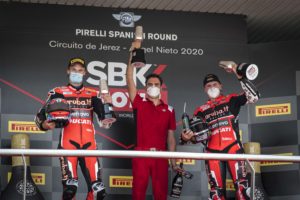
SBK a Jerez: avanti tutta!
A Jerez de la Frontera, seconda tappa del campionato SBK, si ri-accende lo spettacolo con Ducati protagonista. Doppietta di Redding e secondo posto in gara 2 per Davies.
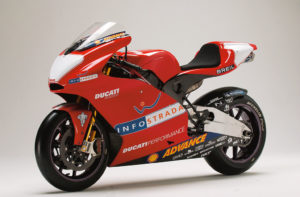
Come nasce la Ducati Desmosedici da MotoGp
Ripercorriamo insieme la nascita della Desmosedici: la moto con la quale, in soli cinque anni, Ducati ha conquistato il tetto del mondo.

